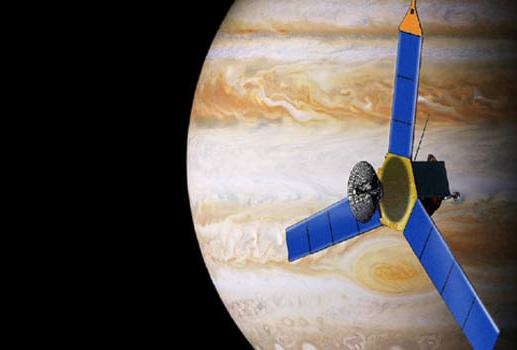NASA prepares a new mission to Jupiter
NASA officially undertook a new task to conduct a very detailed study of the planet.
As Juno, this mission will be the first time a satellite is placed in elliptical orbit around the planet to study its formation, evolution and structure. Under the thick haze, it obscures the mysteries of the fundamental processes and conditions that affect the early solar system.
"Jupiter is the prototype of giant planets in the solar system and formed very early, attracting most of the remaining matter after the Sun was formed," said Scott Bolton from SouthWest Research Institute. San Antonio. "Unlike Earth, Jupiter's enormous mass allows it to retain its original composition, providing us with a way to understand the history of the solar system."
Spacecraft will be launched on Atlas boosters from Cape Canaveral, Fla. In August 2011, and will arrive in Jupiter in 2016. The satellite will fly around Jupiter 32 times, passing about 4800 kilometers on top clouds in about a year. This mission will be the first solar-powered satellite designed to operate despite the distance away from the Sun.
"Jupiter is more than 644 million kilometers from the Sun, five times farther away from the Earth to the Sun and Juno is designed to achieve extremely efficient energy."

Juno satellite simulation image.Photo: NASA / JPL
The satellite will use cameras and 9 scientific devices to study the hidden world under the clouds of Jupiter. This set of scientific instruments will examine the existence of an ice core, Jupiter's dense magnetic field, water, and ammonia clouds in the deep atmosphere, and explore the planet's aurora.
"In Greek and Roman mythology, Jupiter's wife Juno looked through Jupiter's clouds to follow her husband's mischief," said Professor Toby Owen. "Our Juno looked through Jupiter's cloud to find signs of water, extremely necessary for life."
Understanding the formation of Jupiter is important for understanding the processes that lead to the development of the rest of the solar system and the conditions that led to the formation of Earth and humanity. Similar to the Sun, Jupiter consists mainly of hydrogen and helium. However, Jupiter has a large part of the material heavier than the Sun.
"Determining precisely the gravity and magnetic field of Moc Tinh allows us to understand what's inside the planet . " "This measurement and other measurements will tell us the distribution of the physical components of the planet, formation and evolution, which is a key part of our understanding of the properties of the surface system. God".
Deep in Moc Tinh's atmosphere, under great pressure, hydrogen gas is squeezed into liquid. At such depths, hydrogen gas acts as an electrically charged metal that is thought to be the source of the planet's dense magnetic field. Moc Tinh may also have a stone snake at the center.
"Juno gives us a great opportunity to photograph its structure in a way that has never been possible . " "It will allow us to take a long step in our understanding of planet formation and its role in the rest of the solar system."
The Juno mission is a second satellite designed by NASA's New Frontiers program. The first is Pluto New Horizons mission, launched in January 2006 and expected to arrive at Pluto's Charon moon in 2015.
The article was provided by reader Tran Ba Hoang Long.
- NASA prepares to explore the beautiful moon of Jupiter
- NASA spotted a black spot on Jupiter nearly 4,000km long
- NASA's Juno spacecraft is about to approach Jupiter on July 4
- NASA published a detailed photograph of Jupiter's southernmost surface sent by Juno
- NASA announces plans to explore Jupiter's Moon
- NASA prepares a new mission on Mars
- Juno spacecraft completes halfway to Jupiter
- Tomorrow, NASA satellite officially approached Jupiter
- A series of wonderful images of Jupiter are sent from the Juno-NASA ship
- The amazing thing that NASA's Juno spacecraft has just made
- For the first time, humans can discover Jupiter's deepest mystery
- Jupiter was carved by the castle
 Van Allen's belt and evidence that the Apollo 11 mission to the Moon was myth
Van Allen's belt and evidence that the Apollo 11 mission to the Moon was myth The levels of civilization in the universe (Kardashev scale)
The levels of civilization in the universe (Kardashev scale) Today Mars, the sun and the Earth are aligned
Today Mars, the sun and the Earth are aligned The Amazon owner announced a secret plan to build a space base for thousands of people
The Amazon owner announced a secret plan to build a space base for thousands of people